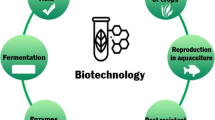Abstract
An artificial diet for rearing the spiny bollworm,Earias insulana (Boisd.), was developed in experiments with three successive generations. The present recommended diet is based on kidney beans, alfalfa meal, whole powdered milk and yeast; methyl-P-hydroxy benzoate, chloramphenicol and formaldehyde were included as preservatives. The effect of the diets on the insect quality is discussed.
Similar content being viewed by others
References
Avidov, Z. and Harpaz, I. (1969) Plant Pests of Israel. Israel Universities Press, Jerusalem.
Kehat, M. and Bar, D. (1975) The use of traps baited with live females as a tool for improving control programs of the spiny bollworm,Earias insulana Boisd., in cotton fields.Phytoparasitica 3: 129–131.
Shorey, H.H. and Hale, R.L. (1965) Mass rearing of nine noctuid species on a simple artificial medium.J. econ. Ent. 58: 522–524.
Yathom, S. (1956) Biology of the spiny boll worm (Earias insulana Boisd.).Ktavim 7(1): 43–57.
Author information
Authors and Affiliations
Additional information
Publication of the Agricultural Research Organization. No. 145-E, 1981 series.
Rights and permissions
About this article
Cite this article
Klein, M., Navon, A., Andreadou, M. et al. Development of an artificial diet for mass rearing of the spiny bollworm,Earias insulana . Phytoparasitica 9, 145–148 (1981). https://doi.org/10.1007/BF03158457
Received:
Revised:
Issue Date:
DOI: https://doi.org/10.1007/BF03158457




